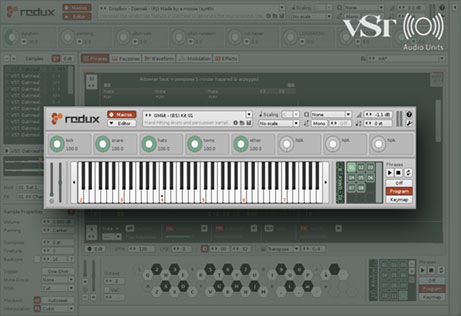Redux (dainsaint) Mac OS
NOW SUPPORTED ON CATALINA
Have you ever wanted to hot rod an Arp Solina String Ensemble? Now you can. SONiVOX’s Solina Redux virtual instrument adds a sweet sounding virtual analog synthesizer to a classic reproduction of an Arp Solina String Ensemble, then throws in TWO fully programmable 8-step sequencers to boot. It’s a match made in heaven and one that produces sonic textures you simply can’t get any other way.
The Arp Solina was the preeminent string ensemble in the 1970’s, made famous by the Eagles, Elton John, Pink Floyd, The Cure, Joy Division, Tangerine Dream, New Order and many others. Its analog Violin, Viola, Cello, Contra Bass, Trumpet and Horn sounds have a sound that creates rich retro sounding orchestral ensembles, especially with its famous “Ensemble” chorus effect.
Solina Redux gives you access to the original Solina sounds, including a model of the Ensemble chorus effect, but includes a modern virtual analog synthesizer as a sidecar. The combination of these two synthesizers provides a sound palette that is both retro and modern or anything in between at your discretion. Each synth includes a multi-mode filter, amplitude and filter envelopes, LFO modulations and send effects.
Redux (dainsaint) Mac Os X
The most common async middleware is redux-thunk, which lets you write plain functions that may contain async logic directly. Redux Toolkit's configureStore function automatically sets up the thunk middleware by default, and we recommend using thunks as. Chichester 1/Redux is the first of a trilogy, and is set in a semi-fictional world where secret organisations covertly battle each other for ideological supremacy. The Story Set before the events of WTC 2, your plans for a mountaineering holiday are thwarted by your nemesis from a rival organisation. Battlezone 98 Redux One of the greatest sci-fi strategy games of all time returns with remastered visuals, online multiplayer and near unlimited mod content from Steam Workshop. Experience thrilling first person action and acclaimed RTS in this explosive alternate vision of the 1960s space race.
To top it off, Solina Redux adds in two fully programmable step sequencers, one for the Solina instrument and one for the analog synthesizer. Play one note and out comes a modern orchestra unlike any you’ve heard. Each step sequencer gives you per step control over the pitch of each note, the volume of each note, the filter cutoff of each note, and the panning of each note. Other controls include gate time, tempo sync, time division, swing, note order and octave shift.
Home > Articles > Apple > Operating Systems
␡- The Layers of Mac OS X: Aqua

This chapter is from the book
This chapter is from the book
There is more than one way to think about dividing up a pizza. First, there is the familiar method of dividing it into slices. Alternatively, you could divide it into layers: topping, cheese, sauce, crust. Theoretically, you could also divide it into its basic ingredients: flour, water, tomatoes, garlic, milk. Each method makes a different contribution to your enjoyment of the pizza. The first method (slices) is best when you're getting ready to eat the pizza; the second is best when you are deciding what to order (such as pepperoni with extra cheese); the third is best if you are concerned about nutrition (needing to know the exact ingredients to calculate calories).
The same is true for Mac OS X. There are multiple ways to look at it and take it apart. Each way makes its own contribution to your understanding of the OS. In this chapter, I look at the major ways to 'take apart' Mac OS X. Having at least a minimal knowledge of Mac OS 9 will help, as I occasionally make comparisons between the two OS versions. But even if you've never used Mac OS 9, you'll be able to follow along.
In This Chapter
The Layers of Mac OS X: Aqua
The Layers of Mac OS X: Application Environments
Cocoa
Carbon
Classic
Java
Putting it together
The Layers of Mac OS X: Graphics Services
Quartz
Multimedia: OpenGL and QuickTime
The Layers of Mac OS X: Darwin
Mach
BSD (Unix)
Domains: An Overview
System domain
Local domain
User domain
Network domain
The Libraries of Mac OS X: /System/Library
Core Services
CFMSupport
Extensions
Fonts
Frameworks
PreferencePanes
Printers
QuickTime
ScreenSavers
Services
Sounds
StartupItems
The Libraries of Mac OS X: /Library
Redux (dainsaint) Mac Os Download
Application Support
ColorSync
Contextual Menu Items
Desktop Pictures
Documentation
Fonts
Internet Plug-Ins
Modem Scripts
Preferences
Printers
Receipts
StartupItems
The Libraries of Mac OS X: Users/'Home'/Library
Application Support
Caches
Favorites
Font Collections
Fonts
Internet Search Sites
Keychains
Preference Panes
Preferences
Application-specific folders
Fonts in Mac OS X: Font Formats
TrueType fonts
PostScript fonts
OpenType fonts
Bitmap fonts
Identifying font formats
Fonts in Mac OS X: Working with Fonts
Font Panel window
Font smoothing and Mac OS X
International language support: basics
International language support: troubleshooting
Font utilities
The Layers of Mac OS X: Aqua
Aqua is the name given to what most users think of when they think of Mac OS X: the user interface, the Finder, the Dock, the windows, the translucent buttons, the high-resolution icons, the menus, and all the rest. Many users may never explore Mac OS X beyond its Aqua layer.
From this perspective, a user upgrading from Mac OS 9 will feel quite at home, at least initially. Much still works the same way. You still double-click icons in the Finder to launch them; you still choose the Save command from an application's File menu to save a document; you still open a folder icon to see its contents.
But you will soon notice some significant differences: a new column view, a very different Apple menu, the Dock. I discussed the basics in Chapter 3, when I presented an overview of Mac OS X.